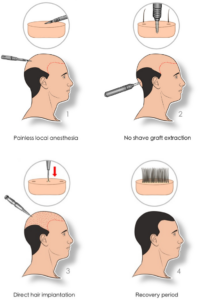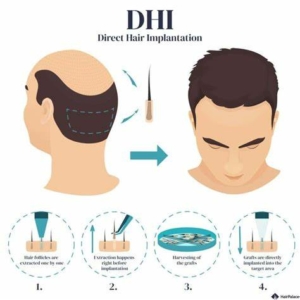Direct Hair Implantation or DHI

Dr Kelemen the founder of Hair 4 Life Medical
What is Direct Hair Implantation or DHI?

DHI process
Direct hair implantation (DHI) is a modification of the FUE technique created by the company DHI Global Medical Group. Direct Hair Implantation (DHI) is a modern, minimally invasive hair transplant technique used to treat hair loss. Some facts to remember about DHI:
- Hair Follicle Extraction: Healthy hair follicles are extracted individually from a donor area, usually at the back of the head, using a specialized tool.
- Follicle Preservation: The extracted follicles are kept in a solution that maintains their viability and vitality until they are implanted.
- Implantation: Using a tool called a Choi Implanter Pen, hair follicles are implanted directly into the recipient area. This allows for precise angle, depth, and direction control, closely mimicking natural hair growth.
- No Incisions or Stitches: DHI doesn’t require incisions or stitches, which often results in a faster recovery time and less scarring same as FUE.
- Natural Results: The precision of the implantation process typically yields very natural-looking results.
DHI differs from other techniques like Follicular Unit Extraction (FUE) in its direct implantation method, which can increase the efficiency and control of the procedure.
Benefits of DHI

DHI process in a nutshell.
Direct Hair Implantation (DHI) offers several benefits over traditional hair transplant methods. Here are some key advantages:
- Natural Results: – DHI provides high precision in angle, depth, and direction of implantation, which ensures that the implanted hair grows in a natural pattern.
- No Need for Incisions or Sutures: – Unlike some other methods, DHI does not require pre-made incisions in the recipient area, reducing trauma to the scalp and facilitating quicker healing.
- Minimal Scarring: – The use of a fine-tipped Choi Pen helps minimize scarring in both the donor and recipient areas, making it ideal for those who prefer keeping short hairstyles.
- Faster Recovery: – The minimally invasive nature of DHI allows for quicker recovery times. Patients can often resume normal activities within a few days after the procedure.
- Higher Survival Rate of Grafts: – By minimizing the time follicles spend outside the body and using advanced preservation techniques, DHI enhances the survival rate of transplanted hair follicles.
- Precise Density and Placement: – The precision of the DHI technique allows for optimal hair density and natural distribution, which can be adjusted based on the patient’s needs.
- Reduced Risk of Complications: – With its minimally invasive approach, the risk of infection and other complications is lower compared to traditional methods.
- Customization: – Detailed planning and the flexibility of the Choi Implanter Pen allow for a highly personalized approach, tailoring the hairline and density to the individual’s specific preferences.
- No Shaving Required: – Unlike some other methods, DHI may not always require shaving the recipient area, which can be a significant benefit for some patients.
These advantages make DHI a popular choice for individuals seeking a natural and efficient hair restoration solution. However, it’s essential to consult with a qualified hair restoration surgeon to determine if DHI is the right method based on one’s specific hair loss condition and goals.
People with androgenic alopecia, which is the most common type of hair loss, make the best candidates for hair implantations. This condition is commonly referred to as male or female pattern hair loss.
The following characteristics also make you a good candidate for hair transplantation:
- Age. People who get hair implants should be over age 25. Hair loss before this age is more unpredictable.
- Hair diameter. People with thicker hair usually achieve better results than people with thinner hair. Thicker hair gives each hair follicle more coverage.
- Donor hair density. Patients with a hair density of fewer than 40 folliclesTrusted Source per square centimeter at their donor site are considered poor candidates for hair transplants.
- Hair color. People with light hair or with a hair color close to their skin tone often achieve the best results.
- Expectations. People with realistic expectations are most likely to be satisfied with their results.
Cons
One of the biggest cons of DHI hair transplant is that it is usually more expensive than other methods. It is explained by the specialized equipment needed to perform the procedure as well as special additional training for surgeons.
Another disadvantage is that the DHI transplant procedure usually takes more time, for example, FUE for the same number of grafts.
The surgeon requires a lot of skill and knowledge as implantation places are not mapped in advance.
Conclusion
DHI is a modified version of FUE hair implantation. There’s no research available on the effectiveness of DHI specifically, but all types of FUE surgery have the potential to treat hair loss caused by male or female pattern baldness.
Hair implantation surgeries are relatively expensive. If you can’t afford surgery or don’t have access to it, you can try alternatives such as Rogaine or finasteride tablets.
Hair 4 Life Medical: Your Premier Destination for Hair Restoration in Scottsdale, Arizona!
Contact Hair 4 Life in Scottsdale – Dr. Ramona Kelemen (hairforlifeaz.com)
You only have to read the reviews to find out how she empowers her clients to look and feel their best. They leave the clinic with their heads held high knowing that the doctor has their best interest at heart!
To find out which procedure is best suited to your needs, you are invited to come into Hair4Life Medical for a consultation. Treatments are kept as affordable and accessible as possible so come in and talk to us.
Contact Us or call Hair 4 Life at (480) 525-4547 to schedule an appointment.
References:
DHI Hair Transplant vs. FUE, Pros & Cons, Recovery – RealSelf
DHI Hair Transplant Procedure: Benefits, Side Effects, How It Works (healthline.com)
DHI Hair Transplants: an Overview, Cost & More (clinicadvisor.com)




